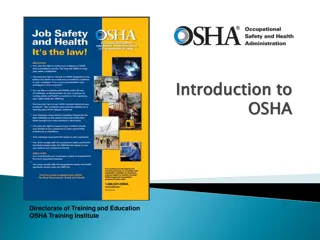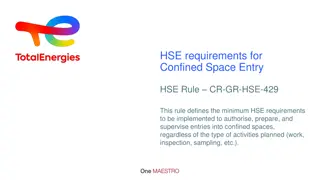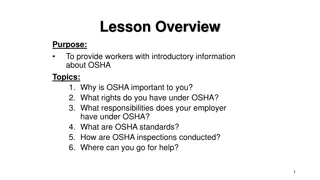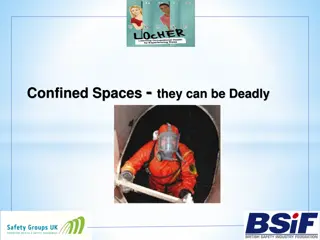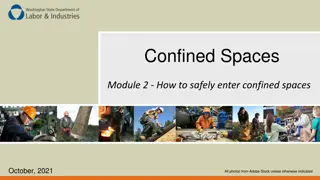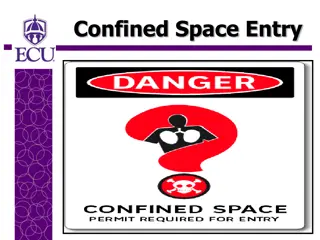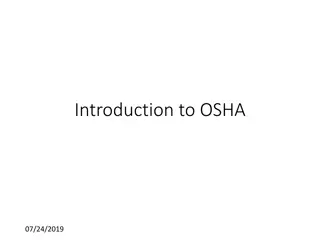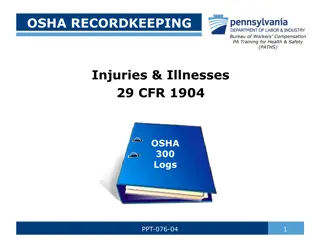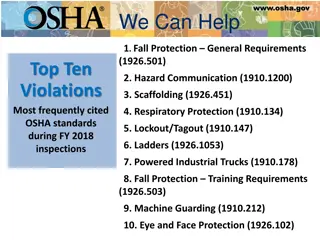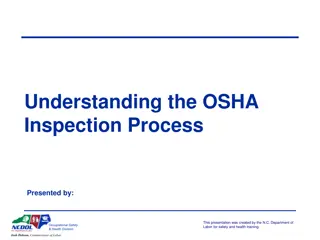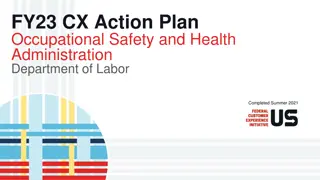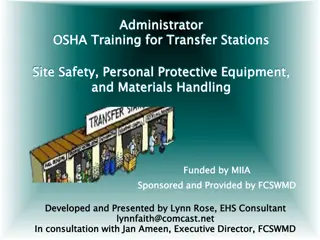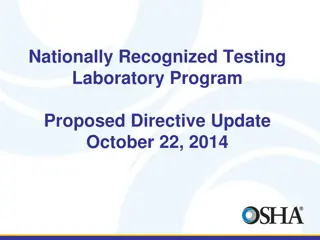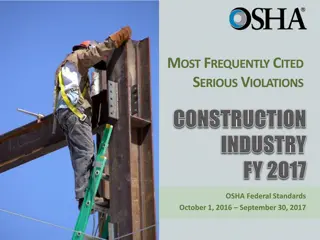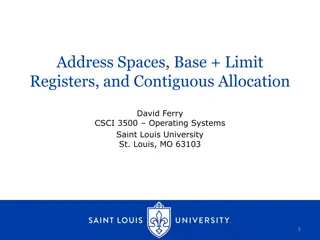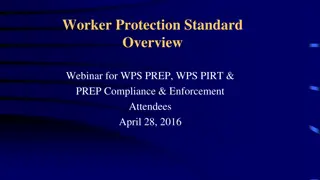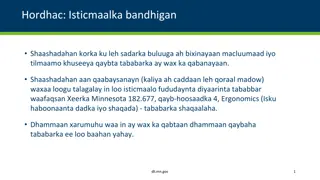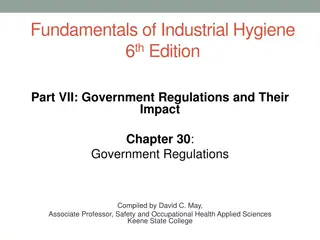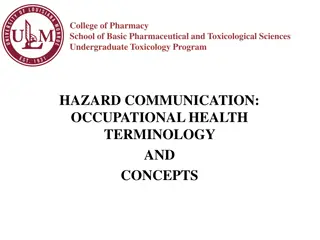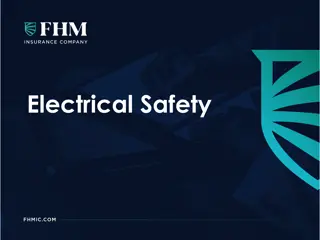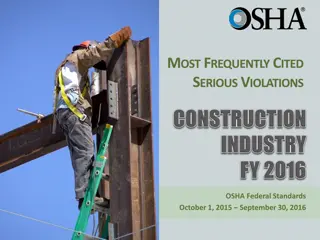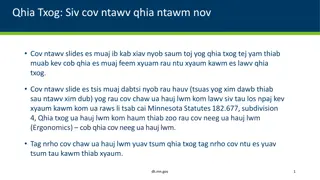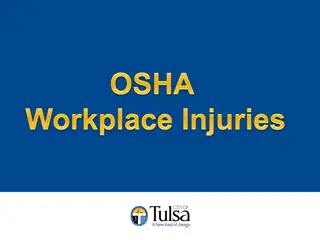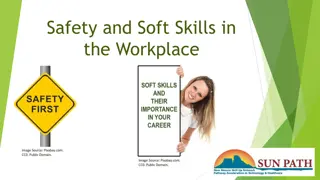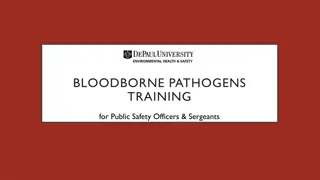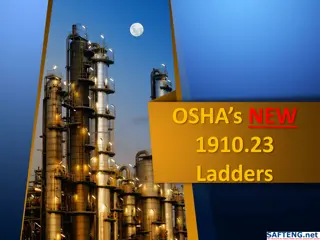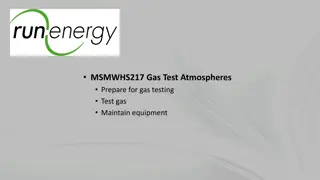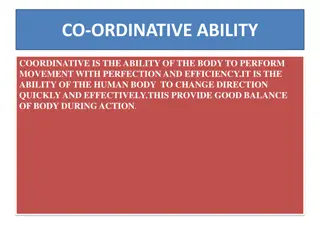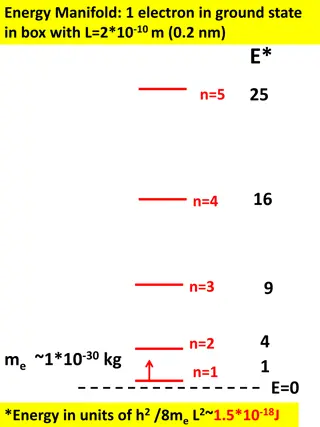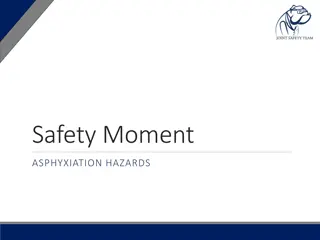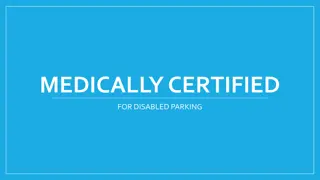Understanding Confined Spaces and OSHA Standards
Explore the importance of confined space standards enforced by OSHA to protect workers from potential hazards. Learn about common confined spaces, identification criteria, and the concept of bodily entry. Discover why it's crucial to adhere to safety regulations in confined spaces to prevent accidents and fatalities.
Download Presentation

Please find below an Image/Link to download the presentation.
The content on the website is provided AS IS for your information and personal use only. It may not be sold, licensed, or shared on other websites without obtaining consent from the author. Download presentation by click this link. If you encounter any issues during the download, it is possible that the publisher has removed the file from their server.
E N D
Presentation Transcript
https://encrypted-tbn0.gstatic.com/images?q=tbn:ANd9GcShBDb0yZ_ODKtGzHE9PKN-cOaZ5VQ8YbWrzP9CqNnz-zgLtodXhttps://encrypted-tbn0.gstatic.com/images?q=tbn:ANd9GcShBDb0yZ_ODKtGzHE9PKN-cOaZ5VQ8YbWrzP9CqNnz-zgLtodX Is there a Grizzly in your Confined Space?
Maybe not, But that s how we should treat them.
Why do we have a Confined Space standard? 122 confined space accidents each year lead to 176 fatalities. 60% of the fatalities occurred during rescue attempts.
Intended to protect workers from: toxic, flammable, explosive, or asphyxiating atmospheres possible engulfment any otherrecognized serious hazard (e.g. - hazardous energy) The standard focuses on areas with immediate health or safety risks, denoting them as Permit Required Confined Space
In other words: When it comes to confined spaces, you re guilty until proven innocent. OSHA assumes every confined space you have requires a permit to get into unless you prove otherwise. You ve got to prove AND document the status of every confined space on your property.
Common Confined Spaces Scale Pit Shredder Baler/Logger Bag House Oil/Water Separator Tank Z-box
How to Identify Confined Spaces 1.Limited Openings for Entry and Exit; AND 2.Is large enough and so configured that an employee can bodily enter and perform assigned work; AND 3.Not Designed for Continuous Worker Occupancy
Definition of Bodily Enter Bodily enter means the action by which a person passes through an opening into a confined space. Entry includes ensuing work activities in that space and is considered to have occurred as soon as any part of the entrant's body breaks the plane of an opening into the space.
Dangerous Combinations Presence of all three confined space characteristics can complicate the situation. Working in and around the space. Rescue operations during emergencies. Worsened conditions due to work activities: Welding and cutting Cleaning with solvents, use of other chemicals Use of gas-powered equipment
Permit Required Confined Space 1. Contains or has a potential to contain a hazardous atmosphere; 2. Contains a material that has the potential for engulfing an entrant; 3. Has an internal configuration such that an entrant could be trapped or asphyxiated by inwardly converging walls or by a floor which slopes downward and tapers to a smaller cross section; or 4. Contains any other recognized serious safety or health hazard.
Permit-Required Confined Space Confined Space 1. Limited Openings for Entry & Egress 1. Hazardous atmospheres 2. Large enough to bodily enter and perform work 2. Engulfment 3. Trapped or asphyxiated by inwardly converging walls or by a floor 3. Not designed for continuous worker occupancy 4. Contains any other recognized serious safety or health hazard
Hazardous Atmosphere 1. Flammable gas, vapor, or mist in excess of 10% of its lower flammable limit (LFL); 2. Airborne combustible dust at a concentration that meets or exceeds its LFL; 3. Atmospheric oxygen concentration below 19.5% or above 23.5%; 4. Atmospheric concentrations of any substance for which a dose or PEL is published in Subpart G or Z of this Part and which could result in employee exposure in excess of its dose or PEL; 5. Any other atmospheric condition that is IDLH
Employers are required to evaluate workplaces to determine if any spaces are permit-required confined spaces.
Signs http://ehs.wsu.edu/ohs/images/ConfineSpaceSign.jpg Employees must be informed of the existence of confined spaces through the use of signs and/or labels.
Entering Permit Spaces If employees will enter permit spaces, the employer shall develop and implement a written permit space program The written program shall be available for inspection by employee and their authorized representatives
Contractor Obtain any available information regarding permit space hazards and entry operations Coordinate entry operations with host employer Inform the host employer of any hazards confronted or created in permit spaces, either through debriefing or during entry operations
Hazards of Confined Spaces Oxygen Deficient Atmospheres Oxygen Enriched Atmospheres Flammable Atmospheres Toxic Atmospheres Temperature Extremes Engulfment Hazards Noise, Slick/Wet Surfaces, Falling Objects
Oxygen Deficient Atmospheres 19.5 % 15 - 19% 12-14% 10-12% 8-10% 6-8% 4-6% Minimum acceptable oxygen level. Decreased ability to work strenuously. Impair coordination. Early symptoms. Respiration increases. Poor judgment. Respiration increases. Lips blue. Mental failure. Fainting. Nausea Unconsciousness. Vomiting. 8 minutes - fatal, 6 minutes - 50% fatal 4-5 minutes - possible recovery. Coma in 40 seconds. Death
Oxygen Deficient Atmospheres Exposure to atmospheres containing 12% or less oxygen will bring about unconsciousness without warning and so quickly that individuals cannot help or protect themselves.
Oxygen Enriched Atmospheres Oxygen level above 23.5%. Causes flammable and combustible materials to burn violently when ignited. Hair, clothing, materials, etc. Oil soaked clothing and materials. Never use pure oxygen to ventilate. Never store or place compressed tanks in a confined space. http://airandspace.si.edu/collections/imagery/apollo/PATCHES/Apollo1patch.jpg
Flammable Atmospheres The byproducts of work procedures can generate flammable or explosive conditions within a confined space. https://encrypted-tbn2.gstatic.com/images?q=tbn:ANd9GcRJ-5gYqOe5Zyz_7mlz4xhiXmBwMLll4SGq7bxVSkQKk9NyRnUH
Confined Space Testing FOUR-GAS DETECTOR Oxygen content Flammability / explosion potential Carbon monoxide Hydrogen sulfide CRITICAL ISSUES Training Procedures Calibration
Testing The Atmosphere Verify presence of safe work atmosphere. Test all areas of a confined space. Top, Middle, Bottom Methane is lighter than air. Carbon Monoxide is the same as air. Hydrogen Sulfide is heavier than air. Oxygen Deficiency.
Lockout/Tagout First option to eliminate hazards. Locking and tagging out electrical sources. Blanking and bleeding pneumatic and hydraulic lines. Disconnecting mechanical drives and shafts. Securing mechanical parts. Locking and tagging out shutoff valves.
Ventilation Must be aware of hazards you are trying to correct in the confined space. Air intake in a safe location to draw fresh air only. Continuous ventilation whenever possible. Retest the confined space before entry.
Engulfment Hazards Material on Feed conveyors Fluff Flooding of confined space. Water or sewage flow.
Authorized Entrants Entrants must: Know the hazards they are facing Be able to recognize signs and symptoms of exposure Understand the consequences of exposure to hazards Communicate with attendants as necessary Alert attendants to warning signs or existence of a hazardous condition Exit when ordered or alerted
Attendants Attendants must: Be aware of behavioral effects of potential exposures Maintain count and identity of entrants Remain outside the space until relieved Communicate with entrants Monitor activities inside and outside the space and order exit if required
Attendants (cont) Attendants must: Summon rescuers is necessary Prevent unauthorized entry Perform non-entry rescue Attendants may NOT perform other duties that interfere with their primary duty to monitor and protect!
Entry Supervisors Entry Supervisors must: Issue confined space permits Know hazards Verify that all tests have been conducted Verify that all procedures and equipment are in place before signing a permit Terminate entry if necessary and cancel permits
Entry Supervisors (cont.) Verify availability of rescue services and means for summoning them Remove unauthorized individuals, terminate entry if necessary, and cancel permits Coordinate shift change
Permit Entry Systems Written permit signed by entry supervisor. Verifies pre-entry precautions have been taken and the space is safe to enter. Posted at entry to confined space. Specifies apparent hazards and corrective actions taken prior to entry. Requires termination of permit when task is completed or when new conditions exist.
Entry Permit Requirements Date, location, and name of confined space. Purpose of entry and known hazards. Duration of entry permit time. Authorized entrants, attendants, supervisors. Air testing results - signature of tester. Protective measures to be taken. Ventilation, Isolation, Flushing Lockout / Tagout, Purging
Entry Permit Requirements Name and phone numbers of rescue and emergency services. Communication procedures. Special equipment and procedures. Personal protective equipment. Alarm procedures. Rescue equipment. Respirators.
Training and Education All workers who must enter confined spaces All attendants and rescue team members. Prior to initial work assignment. Retraining: Job duties change. Change in permit-space program. New hazards are present. Job performance indicates deficiencies.
Training and Education Training and emergency drills should be conducted once a year or whenever the procedure or process changes Records for training must include: Name of employee(s) Signature of trainer(s) Date(s) of training and Must be retained for 3 years
ENTRY PERMIT PERMIT VALID FOR 8 HOURS ONLY. ALL COPIES OF PERMIT WILL REMAIN AT JOB SITE UNTIL JOB IS COMPLETED DATE: - - SITE LOCATION and DESCRIPTION ______________________________ PURPOSE OF ENTRY ______________________________________________________ SUPERVISOR(S) in charge of crews Type of Crew Phone # _______________________________________________________________________ _______________________________________________________________________ COMMUNICATION PROCEDURES ______________________________________________ RESCUE PROCEDURES (PHONE NUMBERS AT BOTTOM) ___________________________ _______________________________________________________________________ * BOLD DENOTES MINIMUM REQUIREMENTS TO BE COMPLETED AND REVIEWED PRIOR TO ENTRY* REQUIREMENTS COMPLETED DATE TIME Lock Out/De-energize/Try-out ____ ____ Line(s) Broken-Capped-Blanked ____ ____ Purge-Flush and Vent ____ ____ Ventilation ____ ____ Secure Area (Post and Flag) ____ ____ Breathing Apparatus ____ ____ Resuscitator - Inhalator ____ ____ Standby Safety Personnel ____ ____ Full Body Harness w/"D" ring ____ ____ Emergency Escape Retrieval Equip ____ ____ Lifelines ____ ____ Fire Extinguishers ____ ____ Lighting (Explosive Proof) ____ ____ Protective Clothing ____ ____ Respirator(s) (Air Purifying) ____ ____ Burning and Welding Permit ____ ____ Note: Items that do not apply enter N/A in the blank. **RECORD CONTINUOUS MONITORING RESULTS EVERY 2 HOURS CONTINUOUS MONITORING** Permissible _________________________________ TEST(S) TO BE TAKEN Entry Level PERCENT OF OXYGEN 19.5% to 23.5% ___ ___ ___ ___ ___ ___ ___ ___ LOWER FLAMMABLE LIMIT Under 10% ___ ___ ___ ___ ___ ___ ___ ___ CARBON MONOXIDE +35 PPM ___ ___ ___ ___ ___ ___ ___ ___ Aromatic Hydrocarbon + 1 PPM * 5PPM ___ ___ ___ ___ ___ ___ ___ ___ Hydrogen Cyanide (Skin) * 4PPM ___ ___ ___ ___ ___ ___ ___ ___ Hydrogen Sulfide +10 PPM *15PPM ___ ___ ___ ___ ___ ___ ___ ___ Sulfur Dioxide + 2 PPM * 5PPM ___ ___ ___ ___ ___ ___ ___ ___ Ammonia *35PPM ___ ___ ___ ___ ___ ___ ___ ___ * Short-term exposure limit: Employee can work in the area up to 15 minutes. + 8 hr. Time Weighted Avg.: Employee can work in area 8 hrs (longer with appropriate respiratory protection). REMARKS:_____________________________________________________________ GAS TESTER NAME INSTRUMENT(S) MODEL SERIAL &/OR & CHECK # USED &/OR TYPE UNIT # ________________ _______________ ___________ ____________ ________________ _______________ ___________ ____________ SAFETY STANDBY PERSON IS REQUIRED FOR ALL CONFINED SPACE WORK SAFETY STANDBY CHECK # CONFINED CONFINED PERSON(S) SPACE CHECK # SPACE CHECK # ENTRANT(S) ENTRANT(S) ______________ _______ __________ _______ __________ _______ ______________ _______ __________ _______ __________ _______ SUPERVISOR AUTHORIZING - ALL CONDITIONS SATISFIED____________________ DEPARTMENT/PHONE ___________________________ AMBULANCE 2800 FIRE 2900 Safety 4901 Gas Coordinator 4529/5387 Sample Confined-Space Entry Permit
Reclassification Form for Permit-Required Confined Space For Potential Lockout Hazards Only A Permit Confined Space can be reclassified into a non-permit confined space if: 1. The space does not contain actual or potential atmospheric hazards: Examples: If you are torching or welding you could create an atmospheric hazard. If you are welding or torching complete both sides of this form. If you are using any chemicals then the space is permit required. If you must enter the permit confined space to lockout, tagout, blankout or block any hazard then a confined space entry permit must be completed. This permit is valid only while the confined space remains free from hazards. If hazards arise during the course of entry, the space must be evacuated immediately and re-evaluated for hazards. The reclassification is valid only for the specific entry indicated below. ________________________________________________________________ Location ___________________________________________ Space Description: Baler Box and Ram Area / Shear Box and Shear Area Shredder Mill / Shredder UMO / Scale Pit Other: ______________________________________________________ Purpose of entry: Cleaning / General Maintenance / Inspection / Weld/Torch Other: ________________________________________________________ Hazard Originally In Space (LO, Gravitational, Fall, etc) Hazard Comments: ____________________________________________________________ ______________________________________________________________________ Certified By: ________________________________________ Date: _______________ Entrant(s)___________________________/___________________________________ Print Initials Print Initials _______________________________________________/_________________________________________________ Print Initials Print Initials Verified By Methods of Elimination of This from must be maintained by the plant for inspection for 1 year.
Confined Space Reclassification Form For Welding /Torching Operation or Potential Toxic Spaces ocation of Confined Space (be specific) _____________________________________ Complete the following PRIOR to entry into each confined space considered for reclassification to a non- permit confined space. If any of the questions below are answered yes, describe how the hazard has been eliminated. 1) Description of work activity: ___________________________________________________________ 2) Atmospheric conditions: Is there a potential for an oxygen enriched atmosphere caused by leaking tanks, hoses, etc? Y N Is there a potential for toxic contaminants i.e.: carbon monoxide, hydrogen sulfide, methane, etc? Y Is there a potential for an explosive or flammable atmosphere (leaking pipes, hoses, tanks Propane, Acetylene, painting or cleaning chemicals? ) Y N Will work or activity in the area of the space create a hazardous atmosphere as explained above? (Are vehicles running are LP or other tanks stored or used near the space, etc) Y N I certify that all known or potential hazards have been appropriately eliminated prior to entry into the above space, thereby allowing for the reclassification of the space as a Non-Permit Confined Space. Reclassification Authorization By: _________________________________________________________ Print Signature Date/ Time If at any time during the entry the hazards change entrants MUST immediately vacate the space. Time Location of reading % Oxygen 19.5 23.5% % LEL Below 10% Carbon Monoxide Below 35 ppm Notes i.e. pre entry reading, start of work, closed Atmosphere Tested By: Initials. Instrument Make/Model _______________________ Serial Number __________________ Calibration Date _______________ Comments / Problems or Hazards found: _________________________________________________________ __________________________________________________________________________________________ Job completed and all employees out of space at ______________________ Final inspection by: _________________________________________________________________________ Print Signature Date Entrants:_____________________________/_________________________________________/__________________________________ Print Initials Print Initials Print initials This from must be maintained by the plant for inspection for 1 year.
The Necessity of Rescue Entrants are in spaces that could quickly render them unconscious Over 60% of fatalities in confined spaces are would-be rescuers A pre-planned and effectively executed rescue saves lives Entry programs that by-pass safeguards will eventually end up requiring rescue
Rescue Members are Trained: To perform assigned duties As entrants In first aid and CPR (at least one member holds current certification) To be proficient in use of personal protective equipment To practice rescue at least once every 12 months
Questions? THANK YOU! Joe Bateman ISRI Safety joebateman@isri.org 615-517-2251


